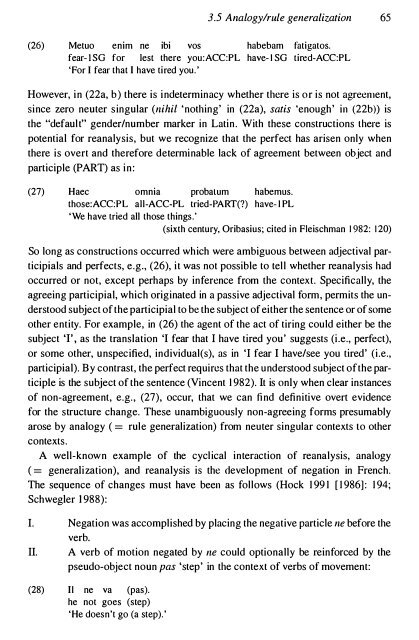Gram - SEAS
Gram - SEAS
Gram - SEAS
You also want an ePaper? Increase the reach of your titles
YUMPU automatically turns print PDFs into web optimized ePapers that Google loves.
3.5 Analogy/rule generalization 65<br />
(26) Metuo enim ne ibi vos habebam fatigatos.<br />
fear- ISO for lest there you:ACC:PL have- ISO tired-ACC:PL<br />
'For I fear that I have tired you.'<br />
However, in (22a, b) there is indeterminacy whether there is or is not agreement,<br />
since zero neuter singular (nihil 'nothing' in (22a), satis 'enough' in (22b)) is<br />
the "default" gender/number marker in Latin. With these constructions there is<br />
potential for reanalysis, but we recognize that the perfect has arisen only when<br />
there is overt and therefore determinable lack of agreement between object and<br />
participle (PART) as in:<br />
(27) Haec omnia probalum habemus.<br />
those:ACC:PL all-ACC-PL tried-PART(?) have- I PL<br />
'We have tried all those things.'<br />
(sixth century, Oribasius; cited in Fleischman 1982: 120)<br />
So long as constructions occurred which were ambiguous between adjectival participials<br />
and perfects, e.g., (26), it was not possible to tell whether reanalysis had<br />
occurred or not, except perhaps by inference from the context. Specifically, the<br />
agreeing participial, which originated in a passive adjectival form, permits the understood<br />
subject of the participial to be the subject of either the sentence or of some<br />
other entity. For example, in (26) the agent of the act of tiring could either be the<br />
subject '1', as the translation 'I fear that I have tired you' suggests (i.e., perfect),<br />
or some other, unspecified, individual(s), as in 'I fear I have/see you tired' (i.e.,<br />
participial). By contrast, the perfect requires that the understood subject of the participle<br />
is the subject of the sentence (Vincent 1982). It is only when clear instances<br />
of non-agreement, e.g., (27), occur, that we can find definitive overt evidence<br />
for the structure change. These unambiguously non-agreeing forms presumably<br />
arose by analogy ( = rule generalization) from neuter singular contexts to other<br />
contexts.<br />
A well-known example of the cyclical interaction of reanalysis, analogy<br />
( = generalization), and reanalysis is the development of negation in French.<br />
The sequence of changes must have been as follows (Hock 1991 [1986]: 194;<br />
Schwegler 1988):<br />
I. Negation was accomplished by placing the negative particle ne before the<br />
verb.<br />
II. A verb of motion negated by lie could optionally be reinforced by the<br />
pseudo-object noun pas 'step' in the context of verbs of movement:<br />
(28) II ne va (pas).<br />
he not goes (step)<br />
'He doesn't go (a step).'
















